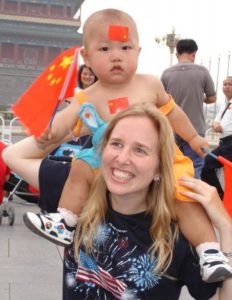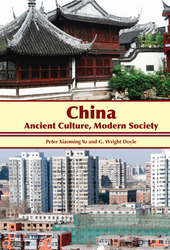China: Ancient Culture, Modern Society by Peter Xiaoming Yu and G. Wright Doyle. AEG Publishing Group, forthcoming in October, 2009, 244 pages; ISBN: 978-1-60860-635-1.
Reviewed by Tricia Bølle
In the 16th and 17th centuries, Jesuit missionaries realized the efficacy of seeking a genuine under-standing and appreciation of the peoples and cultures of the far reaches of the earth where they sought to bring God’s Word. The missionaries spent years living among the people they preached to, educating themselves how to more effectively teach the gospel in a manner that might be better understood. They accomplished this through their interactions with the people and by preaching in a context culturally familiar to those who received it. This was done not only for proselytization purposes, but also to show respect for the foreign people and culture that they worked among. This kind of social immersion and education in a foreign culture is no less important to Christian service today as it was five hundred years ago. In fact, it has become a well understood aspect of missiology that is encouraged in all those who seek to fulfill the Great Commission in their lives both at home and abroad. It is with this in mind that Peter Xiaoming Yu and G. Wright Doyle have written China: Ancient Culture, Modern Society to assist those who actively participate in China service.
China: Ancient Culture, Modern Society is not meant to be an in-depth academic text on Chinese history, culture or contemporary social issues. Rather, it acts as a general primer for those who are relatively unfamiliar with China as well as those who have spent some time there but want to gain a stronger general knowledge of Greater China. What this book lacks in depth and academic analysis, it achieves in breadth and concision. Because of the book’s brevity—covering major highlights of Chinese history, literature, art, religion, society and contemporary social issues—it can be easily read in a few short sittings, making it possible to gain a basic understanding of China with little initial effort. Rather than lengthen the text with extensive detail on each of the wide variety of topics, the authors encourage the reader to seek further education through a list of suggested works by noted scholars in the field. By this reasoning, one can pursue a topic of interest without being slowed down by having to plow through other sections of less interesta very attractive option indeed considering the length of time one could easily devote towards learning further about even one aspect of this great country and its people.
China: Ancient Culture, Modern Society is divided into four parts with the authors’ contributions alternating between various sections, drawing off of each author’s respective familiarity with China from a native’s standpoint versus that of a Westerner’s. This dual perspective offers from one author the benefit of having a factually accurate account of China nuanced with small details that would matter more to someone with a native Chinese education. From the second author, this style of writing is able to simultaneously cater to the curiosities of those who are relatively unfamiliar with, but seeking to learn more about, China’s story.
A clear example of this would be Peter Xiaoming Yu’s description of early Chinese history and the influence that important historical figures had on the development of modern Chinese society, written with the admiration of one who was raised revering his rich heritage. While China’s history is quite broad, Yu is able to touch upon the major events and personalities with an intimate knowledge that few foreigners not raised within Chinese society would be capable of. In doing so, Yu gives the reader more than just the standard textbook account of China’s vast history; rather, he portrays his country’s history in a way that hopefully lends greater understanding to the foreigner trying to grasp the immensity of China’s contemporary society and the people and events that formed it. He caps the history section accordingly with a bit of insight about the work ahead of China’s political leaders: “To lead a country with a history of more than 6,000 years is an art that needs creativity, to guide a 1.3 billion population requires wisdom that desires humility, and to handle China’s domestic and international challenges is an act that requires vision.”
To complement his coauthor, in his introduction to the book, G. Wright Doyle begins by offering a somewhat stereotyped Western account of how Chinese are often viewed by those who have had limited firsthand knowledge of China. This approach helps its readers not only come to terms with misperceptions about China that they may have themselves, but also allows them to better understand, through Chinese eyes, many of the important issues that help shape modern Chinese society.
Doyle by no means continues in this stereotyped view of the introduction and instead spends the remainder of the text he is responsible for dispelling such misconstrued or, as is often the case with China, over-generalized ideas with relevant information that will appeal to his foreign audience. His brief overview of China’s belief systems, for example, spends considerable effort covering those belief systems—Confucianism, Daoism and so on—and their founders which may seem more foreign to someone not as familiar with Chinese society. Even though only a limited section is devoted to the ever-growing Christian faith within China, as most readers will already have a strong familiarity with Christianity in general, much of what is written focuses on those aspects of the Christian faith that are characteristic to China, both currently and historically. To expound further on the small section written about Christianity, Doyle manages to capture in just a few clear examples the vast disparity of religious freedom that is seen within Chinese society, such that no one situation can be said to be true of the whole of China. This reality exists not only for Christianity, but for all religions within China where government regulations can be very oppressive in some regions and quite open in others.
Yu and Doyle finish their book with a look at China’s contemporary society and the issues that are immediately relevant, especially to those who will be spending substantial time interacting with Chinese on the mainland. From education to the Olympics, the authors touch upon just enough issues to provide motivation to learn more about those issues that catch the reader’s interest.
In short, China: Ancient Culture, Modern Society will serve well those who are looking for a concise and diverse overview of China spanning its history, culture, people and contemporary socio-political situation. Hopefully, for many this book will be a good starting point towards further research and understanding of China that will aid them, like their Jesuit predecessors, in their endeavors to advance God’s Kingdom to the ends of the earth.
Image credit: Fishman in the morning by Kuan Sun, on Flickr

Tricia Bølle
Tricia Bølle has been working with young adults in universities and local faith communities for since 2008. A graduate of Stanford University, she founded an educational nonprofit, DEI in Asia, to develop programs and training to promote personal growth, civic engagement, women’s issues, crisis intervention, and psychological well-being among Chinese university …View Full Bio
